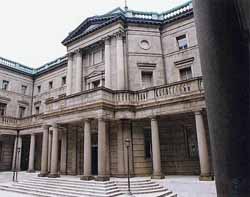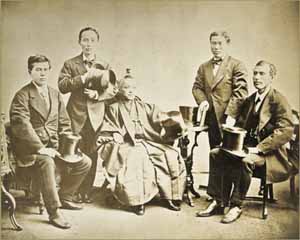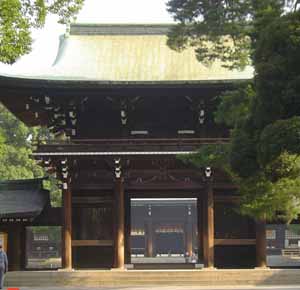 |
|||||
 |
|||||
 |
|||||
 |
|||||
 |
|||||
 |
|||||
 |
|||||
 |
|||||
 |
|||||
 |
|||||
 |
|||||
 |
|||||
 |
|||||
 |
|||||
Meiji Period1868-1912 |
|
||||||||||||||||||||||||||||||||||||||||||||||||||||||||||||||||||||||||||||||||||||||||||||||||||
PRINCE MUTSUHITO | GOALS | WESTERNIZATION | IWAKURA MISSION | BASEBALL | EDUCATION | GLOBAL INTERACTION | MEIJI JINGU
 In
1867 daimyo who supported the emperor
suggested the Tokugawa Yoshinobu step down and acknowledge imperial power. In
November of that year, he agreed, but the imperial palace in Kyoto was seized
on January 3, 1868, and the restoration of the emperor's power was proclaimed.
Prince Mutsuhito was only 15 at the time. He soon took the name Meiji meaning
enlightened government. By 1869, the capital was moved to Edo and renamed Tokyo
or Eastern Capital. Meiji took control of the government and moved the capital
to Edo and renamed it Tokyo.
In
1867 daimyo who supported the emperor
suggested the Tokugawa Yoshinobu step down and acknowledge imperial power. In
November of that year, he agreed, but the imperial palace in Kyoto was seized
on January 3, 1868, and the restoration of the emperor's power was proclaimed.
Prince Mutsuhito was only 15 at the time. He soon took the name Meiji meaning
enlightened government. By 1869, the capital was moved to Edo and renamed Tokyo
or Eastern Capital. Meiji took control of the government and moved the capital
to Edo and renamed it Tokyo.
The new imperial
government had several goals. The first of the goals was a democratic Japan.
The first step in making Japan a democracy was to break down the social class
system enforced by the Tokugawa Shogunate. The samurai
lost all their privileges in this movement. The daimyo
had to return their land to the emperor. By 1870, the land had been returned
and the country was restructured into prefectures.
Basic human rights were established including religious freedom. By 1889, Japan
had its first Western style constitution. The legislative branch established
was a parliament called the Diet.
The Emperor however, kept his power by being the head of the armed forces, the
executive and legislative branches. In reality, the emperor had traded the shogun
for the elite upper class who truly controlled the state.
 The
Meiji Period is one that is synonymous with westernization.
The economy of Japan until this point was largely agrarian.
This time period sees the beginning of industrialization.
In order to best complete this transition, scholars were sent abroad to study
Western science. At the same time, Westerners were teaching in Japan. The government
invested heavily in a new transportation and communication network. Two industries
that developed during this time period were the textile industry and zaibatsu.
Zaibatsu was a group of families that controlled industry, business and/or finance.
The textile industry was the larges industry until World War II. Similar to
the beginning of industry in Europe and the US, conditions in the early factories
were dangerous and led to reform movements. This massive government led change
was not cheap. In the 1880's, the currency system was reformed and the Bank
of Japan (pictured at right) established in response to a financial crisis.
The
Meiji Period is one that is synonymous with westernization.
The economy of Japan until this point was largely agrarian.
This time period sees the beginning of industrialization.
In order to best complete this transition, scholars were sent abroad to study
Western science. At the same time, Westerners were teaching in Japan. The government
invested heavily in a new transportation and communication network. Two industries
that developed during this time period were the textile industry and zaibatsu.
Zaibatsu was a group of families that controlled industry, business and/or finance.
The textile industry was the larges industry until World War II. Similar to
the beginning of industry in Europe and the US, conditions in the early factories
were dangerous and led to reform movements. This massive government led change
was not cheap. In the 1880's, the currency system was reformed and the Bank
of Japan (pictured at right) established in response to a financial crisis.
 In
1871, Iwakura Tomoni led a delegation to study western nations. The Iwakura
Mission (pictured at left) went to the United States, England, and Europe. There
they studied all aspects of western society. Some of the the topics that they
focused on included banking systems, zoos, police forces, education and agriculture.
Part of the mission was leaving school children in these foreign countries with
host families. Another aspect was the invitation of foreigners to come to Japan
and work for the Japanese government.
In
1871, Iwakura Tomoni led a delegation to study western nations. The Iwakura
Mission (pictured at left) went to the United States, England, and Europe. There
they studied all aspects of western society. Some of the the topics that they
focused on included banking systems, zoos, police forces, education and agriculture.
Part of the mission was leaving school children in these foreign countries with
host families. Another aspect was the invitation of foreigners to come to Japan
and work for the Japanese government.
Part
of the westernization of Japan involved the introduction of western sports.
In 1873, a Christian missionary named Horace Wilson organized students into
baseball teams at what would become Tokyo University. Christianity did not have
appeal but baseball did. By 1891, a Japanese team challenged an American Athletic
Club in Yokohama. After five years of resistance, the game was played. To the
surprise of the gaijin crowd, the Japanese
won 29-4. The won again in a rematch with an equally humiliating score for the
Americans. Baseball from this point on grew until it became one of Japan's greatest
past times.
One of the areas that was westernized was the education system. It was modeled after both the French and German system. For the first time, Japan had compulsory education. Most children attended the free public schools for at least six years. The school system was controlled closely by the government. Beyond basic skills like math and reading, Confucian ideas were stressed. Among the ideas stressed were duty to emperor, country and family. Although it was westernized, a nationalistic movement began to move the country back to the principles of Confucianism and Shintoism. The latter included the worship of the emperor. This idea in particular was taught in schools. With Emperor Meiji firmly in control, Shintoism was deemed the preferred religion. Click here for a guide on Shinto Shrines.
On the world stage, the Japanese much like their Asian counterparts had unfair treaties with the West. The emperor learned quickly that Japan had to modernize its military in order to survive in the imperialistic time. One of the first actions of the new government was universal conscription. The Japanese modeled their army after the Prussians and their navy after the British. It was not long before the new military was put to the test. In 1894 and 1895, the Sino-Japanese War took place. This war was centered around conflict between China and Japan over Korea. By the end of the war, Japan had defeated China and received Taiwan. The European powers of Russia, France and Germany forced Japan to return other territories they had secured. This action would come back to haunt Europe. The Triple Intervention by Europe inspired Japan's intense rearmament. In 1904 and 1905, Russia would feel the brunt of the Japanese rearmament. Conflict with Russia over Korea and Manchuria led to the Russo-Japanese War. With Japan's defeat of Russia, they gained not only land but international respect. By 1910, Korea had been annexed.
 Emperor
Meiji died in 1912 ending the Meiji Period and moving Japan toward a new time
period. In 1920, eight years after the emperor's death and six years after his
wife died, a Shinto shrine was constructed for their souls. Meiji Jingu (pictured
at left) is located in Harajuku section of Tokyo. It is located in a 700,000
square foot park. There are three different areas that make up the shrine. The
Naien (inner precinct), Gaien (outer precinct) and the Meiji Memorial Hall.
Although the original buildings were destroyed in the air raids of World War
II, they were rebuilt in 1958. On the way to the shrine, you pass through the
outer gardens called the Gaien include a variety of facilities including sports
arenas and a photo gallery. The
entire area is a wooded park filled with a variety of buildings and gardens.
The entrance to the park is marked by the traditional
torii. As you walk along the path you will pass a variety of buildings and
gardens. One of the more famous is the Iris Gardens. Along the path is a traditional
open air building that houses sake sacrifices.
Due to its picturesque setting, the shrine is a favorite place for young men
and women to get married. Over the years several structures have been built
to accommodate the demand. Within the Naien are several buildings. They consist
of the Main Shrine (click here to see video
footage of the main shrine), The
Naihaiden (the Inner Shrine), Gehaiden
(the Outer Shrine), Shinsenjo (the Consecrated Kitchen for the preparation
of the food offerings) and some office buildings. Click
here to see video footage of the courtyard leading from the inner shrine to
the outer shrine. Before entering through the gate into the courtyard, you
cannot help but notice two structures. The first is the Washing
Temizusha . This is a standard purification trough seen at all Shinto shrines.
The other building holds the traditional
shimenawa with white zigzag
paper strips called gohei. This signifies the holiness of the shrine. Within
the courtyard there is a large tree where
people leave ema. After leaving the Naien,
you may travel a path that will lead you to Shinko
(the Treasure House). In the Treasure House, there are over 100 items of Emperor
Meiji and his wife. Not far from there is a martial arts training school. In
a true testimony to what Emperor Meiji stood for, in the distance from the shrine,
are some of the very modern buildings
of Tokyo. Click here for a guide on Shinto Shrines.
Emperor
Meiji died in 1912 ending the Meiji Period and moving Japan toward a new time
period. In 1920, eight years after the emperor's death and six years after his
wife died, a Shinto shrine was constructed for their souls. Meiji Jingu (pictured
at left) is located in Harajuku section of Tokyo. It is located in a 700,000
square foot park. There are three different areas that make up the shrine. The
Naien (inner precinct), Gaien (outer precinct) and the Meiji Memorial Hall.
Although the original buildings were destroyed in the air raids of World War
II, they were rebuilt in 1958. On the way to the shrine, you pass through the
outer gardens called the Gaien include a variety of facilities including sports
arenas and a photo gallery. The
entire area is a wooded park filled with a variety of buildings and gardens.
The entrance to the park is marked by the traditional
torii. As you walk along the path you will pass a variety of buildings and
gardens. One of the more famous is the Iris Gardens. Along the path is a traditional
open air building that houses sake sacrifices.
Due to its picturesque setting, the shrine is a favorite place for young men
and women to get married. Over the years several structures have been built
to accommodate the demand. Within the Naien are several buildings. They consist
of the Main Shrine (click here to see video
footage of the main shrine), The
Naihaiden (the Inner Shrine), Gehaiden
(the Outer Shrine), Shinsenjo (the Consecrated Kitchen for the preparation
of the food offerings) and some office buildings. Click
here to see video footage of the courtyard leading from the inner shrine to
the outer shrine. Before entering through the gate into the courtyard, you
cannot help but notice two structures. The first is the Washing
Temizusha . This is a standard purification trough seen at all Shinto shrines.
The other building holds the traditional
shimenawa with white zigzag
paper strips called gohei. This signifies the holiness of the shrine. Within
the courtyard there is a large tree where
people leave ema. After leaving the Naien,
you may travel a path that will lead you to Shinko
(the Treasure House). In the Treasure House, there are over 100 items of Emperor
Meiji and his wife. Not far from there is a martial arts training school. In
a true testimony to what Emperor Meiji stood for, in the distance from the shrine,
are some of the very modern buildings
of Tokyo. Click here for a guide on Shinto Shrines.
to return to Mrs. O'Donnell's Home Page.
"Maintained according to the Lakeland
Central School District Web Page Policies and Guidelines."
“Clicking on the above links will direct you to site(s) outside the Lakeland
Central School District and the Lakeland High School server. The Lakeland Central
School District is not responsible for contents on external sites and servers,
nor does the district endorse the sponsors or advertising on these sites.”
This site was designed and maintained by Maureen
O'Donnell, a teacher at Lakeland
High School.
July 2005 Created - |
Thursday, July 28, 2005
Last Revised -